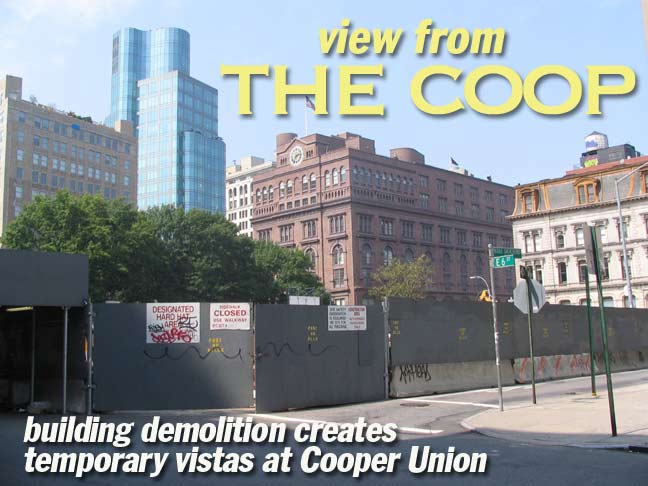Cooper Square (Astor Place at 3rd and 4th Avenues), was named for industrialist and inventor Peter Cooper (1791-1883), the developer of the first practical steam engine. He helped build America’s iron and cable industries (partnering with Samuel Morse in laying the first trans-Atlantic cable), and was one of the first developers of gelatin made from rendering mammal remains. In 1857 he founded Cooper Union for the Advancement of Science and Art in a new brownstone building at one of Manhattan’s true crossroads, the Bowery (originally the Post Road) and Astor Place. The building is supported by steel rails invented by Cooper himself.
In recent years, in fact in recent months, Bowery is redeveloping at break-neck speed; soon all trace of its years as the last stop for down-and-outers in flophouses under the el will be totally gone, as that iteration of the Bowery replaced an earlier version as NYC’s entertainment mecca; as that replaced the Bowery’s earliest role as the road to Peter Stuyvesant’s bower, or farm.
Just as the Bowery rapidly changes, Cooper Union is growing as well. In 2006, the school demolished the Abram S. Hewitt Building, used as a dormitory/living quarters, and will be building a new nine-story, futuristic, Gehry-esque academic building set to house its Albert Nerken School of Engineering, in line to be New York City’s first “green” academic laboratory building.
The demolition of the Hewitt Building has allowed fascinating views that were heretofore unavailable, and will be unavailable again after the new hall has been completed…
Though St. George’s Ukrainian Catholic Church is practically new — having been built in 1977 — it faithfully evokes the Byzantine styles that originated six centuries prior. St. George’s was first established at 1st Avenue and East 20th Street in 1905, and moved to East 7th between 2nd and 3rd Avenues (at Hall Place) in 1911. This new church finally opened in 1978 and at the same time, Hall Place was renamed for Taras Shevchenko (1814-1861) a Ukrainian poet, artist and social reformer known as the Bard of the Ukraine.
St George’s is temporarily visible from Cooper Square and East 7th Street for a few months in the summer and fall of 2007 until steelwork for the new academic building begins to rise.
On the opposite corner of East 7th, we see the Metropolitan Savings Bank building, a Second Empire-style building dating to 1867, clad in marble, now the Abounding Grace Christian Center. Next door is 69 Cooper, an apartment building from 1985.
1867…1985. Esthetically there is no comparison.
Walking around the corner to Taras Shevchenko Place and East 6th Street, we see three wildly divergent eras in NYC architecture: from right, the Metropolitan Bank (1867), Cooper Union (1857) and then, the undulating, glass-clad, amoeba-shaped Astor Place Apartments, called by its creator Charles Gwathmey as “Sculpture For Living” and by local detractors as “The Green Monster.” (2004). Once again, this tryptych will be in view for only a short while, so see it while you can.
Hmmm, Finyl Vinyl (204 East 6th) closed on a Saturday afternoon? Could it have reached finylity? [Yes.] In NYC vinyl isn’t dead as hundreds of used record stores still sell stacks of wax.
Taras Shevchenko Place. It gained eleven letters in 1978, when the name was changed from Hall Place. In a way, the sights on this page are visible as a direct consequence of its presence.
In NYC’s 2010s street sign replacement program, Shevchenko Place regained its Hall Place sign. Perhaps old maps were being used.
No matter what changes the Bowery and Cooper Union undergo, there will always be a McSorley’s Old Ale House, established, they claim, in 1854, though some historians dispute the opening date. Theodore Roosevelt, Woody Guthrie, Boss Tweed, e.e.cummings and dozens of other literary, political, sports and showbiz lights have had the light or dark there. The walls are covered with memorabilia including Houdini’s handcuffs and dust-covered wishbones left by departing soldiers during World War I. The ones that returned took back their wishbones; and the ones who were killed still have their wishbones above the bar, along with 9 decades of dust. The New York Rangers brought the Stanley Cup to McSorley’s after their 1994 victory –and that is one of the few artifacts that has reluctantly left the premises: virtually none of the collected bric-a-brac has been removed since the early 20th Century. Some of the interior can be seen on my Bar Some page.
8/27/07









